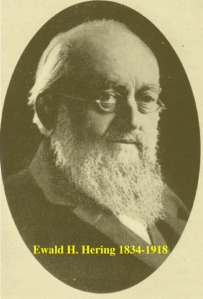Voila, the human eye:
(source 13)
Knowing what the eye looks like is all well and good, but how does it work? How do the light waves that enter your eyes turn into neural impulses and signals?
Light enters the eye via the cornea and is slightly bent as it passes through. It travels to the back of the eye by way of the pupil, which is simply a hole in the center of the eye. The amount of light that is allowed into the eye is controlled by the iris, which, though it is best recognized by its color, is actually a muscle. As the muscle expands or contracts, it causes the pupil to dilate or constrict. The light then passes through the lens, which bends and focuses the image onto the retina. The image is actually projected upside down and mirrored at this stage of the visual process. The main point upon which light is focused on the retina is called the fovea. This central area contains a high concentration of visual receptors called cones, which see color and fine detail. In the periphery are rods, which see dim light. The visual signals are then transferred from the retina to the optic nerve, which carries the information to the brain’s visual centers. The image is then fixed to be correctly oriented and sent to other areas of the brain that deal with perception (11, 12).
Definitions:
Hue: A color or shade as defined by its dominant wavelength (8).

Intensity: Either the lightness of a light source or the brightness of the surface upon which light is reflected. A color’s intensity is determined by its amplitude (9).
Saturation: The purity of a color. A highly saturated color will be nearly pure, whereas an unsaturated color will be mixed with neighboring colors (10).
Photoreceptors are retinal cells used for sensing light that exist in two forms. One, the cone, is used for discerning color and fine details. The other, the rod, can be used to distinguish form and objects in low light (4).
The opponent-process theory is a concept that was developed by Ewald Hering, who is this dashing man right here:

(source 5)
The theory states that photoreceptors are grouped into opposing pairs (red and green, blue and yellow, white and black). The activation of one color in an opposing pair stops the activation of another, so therefore you cannot observe two opposing colors in the same place at the same time. This also explains the afterimage effect. When you look at one color for an extended period of time (without any eye movement) and then look away, you see its opposing color. This happens because the photoreceptor used for an extended period of time becomes tired, so its activity levels decrease. By comparison, the opposing color’s receptor has high activity, so the brain perceives it as you seeing the other color (6).
To test this theory for yourself, click below:
What is nearsightedness? Also called myopia, it results from the lens bending light in such a way that the light is focused before it reaches the retina. This causes anything far away to appear blurry (1). The converse is true in farsightedness, or hyperopia, where light is focused after it passes the retina. Here, items that are too near to the eye are blurry (2). Glasses or contacts can correct both of these issues by bending light artificially as it passes into the retina (3).